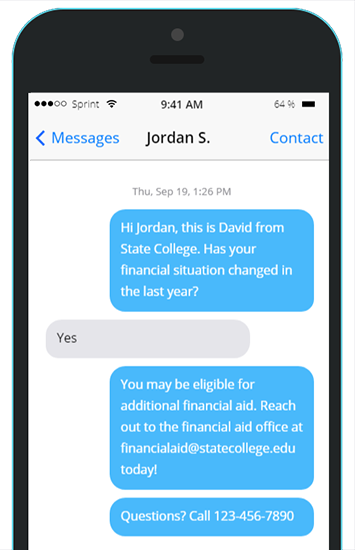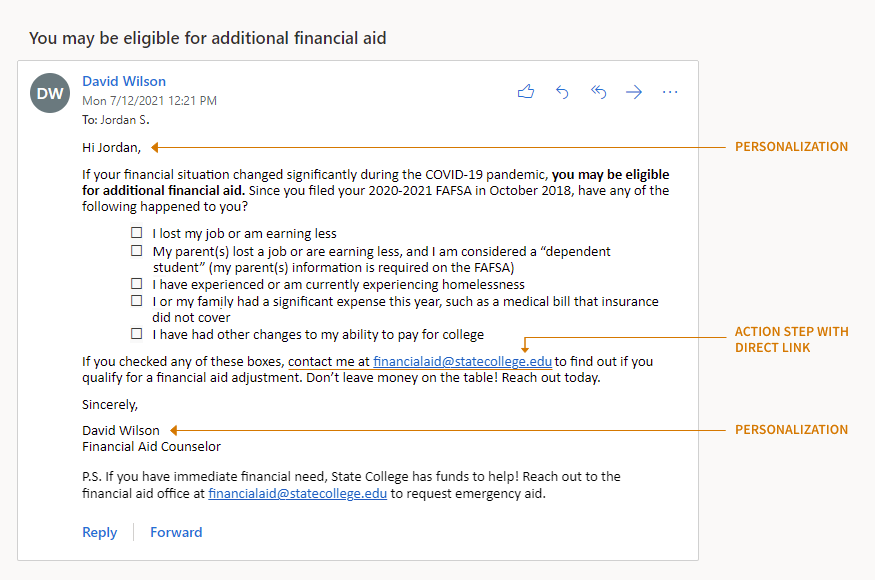Need to Inform Students About Aid Adjustments and Emergency Grants? These Strategies Can Help

For many students, financial aid can make the difference between staying enrolled in school and dropping out, yet students are not always aware of all the financial resources that are available to them. Proactively communicating with students about financial aid can help them get the support they need to remain in college, and the 2021 American Rescue Plan (ARP) Act requires colleges to do just that. Part of the act requires colleges to use some of their Higher Education Emergency Relief Fund (HEERF III) resources to reach out to students proactively, notifying them of the opportunity to receive an adjustment to their financial aid award. Colleges are also distributing emergency aid and should inform students about the availability of funding. The following evidence-based strategies may help college administrators create effective messages that let students know about these opportunities for more financial support in the post-pandemic economic environment.
What should you include in your messages?
- Personalize messages with student information: Including specific information—such as the student’s name or details about their financial aid status—can increase engagement and be automated through mail merge and other software. Adding the sender’s name and contact information, with an explanation that the college is taking the time to reach out to the student makes these messages even more salient—a behavioral science concept known as reciprocity.
- Highlight simple action steps and use direct links: Breaking down processes into clear, manageable steps can facilitate action. Messages that clearly outline any tasks students must complete to apply for emergency aid or request an adjustment may get better responses. Include direct links to online application forms and email addresses. Keep things short and simple—every additional step in a process can be a barrier to action.
How should you send messages?
- Use multiple modes of outreach: Student communication preferences vary. While colleges rely largely on email to connect with students, adding other modes of communication, particularly mailed letters, can help drive important messages home. Findings from MDRC’s EASE project showed that students were more likely to remember receiving physical letters in envelopes than other forms of communication. Mailed letters may be particularly helpful for reengaging students who have stopped attending classes, as these students may not be checking their college email addresses. Colleges may also consider sending text messages and posting on learning management systems (such as Blackboard or Canvas). Sending similar messages via multiple methods can make it more likely that at least one mode will capture a student’s attention—this approach may also help address equity concerns, such as lack of consistent access to the internet or stable housing.
- Add financial aid reminders to messages from multiple departments: To reach more students, get other departments to reiterate that aid is available and that award amounts can be adjusted. Advising, enrollment, and academic support services departments can play a valuable, effective role in these communications. For example, an email about registration might remind students that their financial aid award can be adjusted to help them pay for the next semester, or that emergency aid is available to cover outstanding balances so they can reenroll. Students may be more likely to read outreach from one department or individual over another.
New research on HEERF emergency aid, conducted by the National Association of Student Financial Aid Administrators (NASFAA), MDRC, and NASPA, further supports the critical importance of clear, proactive communications. See the full report of this research for additional information and considerations for policymakers and practitioners.
Below is a sample email and text message that you can use to get the word out to your students.
Sample Email — Award Adjustment
Notes: This email could be customized for your college. For example, you may include the date each student filed a 2020-2021 FAFSA to make the email more personalized or opt for a general time marker to help students understand the timeframe in which changes to their financial situation may qualify them for an aid adjustment. You may also list alternate or additional criteria for students to express financial need.
Tip: The “P.S.” line of the email could be used to inform students about the availability of emergency aid, as shown in the sample message, or used to highlight other resources or student services.
Sample Text Message – Award Adjustment







